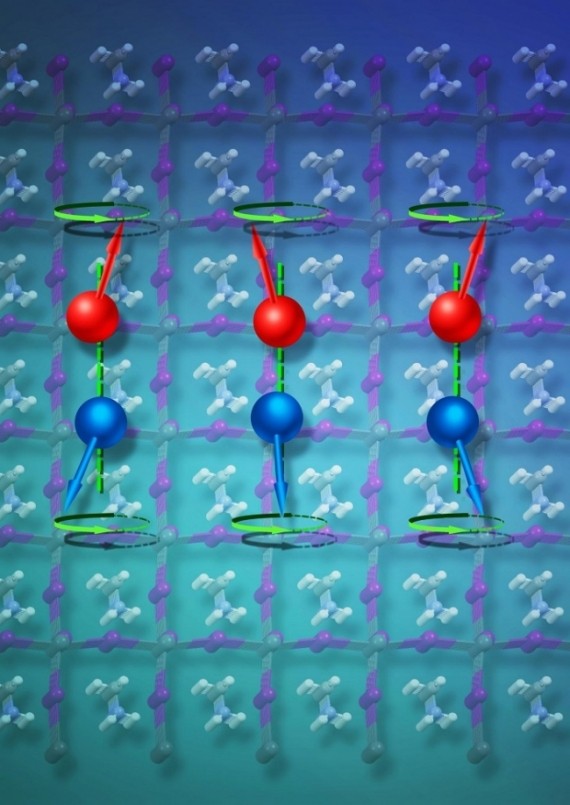Scientists Develop New Method of Creating Perovskite Film for Solar Cells
| Marco Foronda | | Mar 17, 2015 11:43 AM EDT |
(Photo : University of Utah) A schematic presentation of the obtained magnetic field effect of photocarriers in photovoltaic cells and injected carriers in light emitting diodes based on hybrid organic/inorganic perovskite semiconductors.
The best hope for cheap, super-efficient solar power is a remarkable family of crystalline materials called hybrid perovskites.
Based on five years of research and development, the hybrid perovskite solar cells are now able to attain conversion efficiencies that previously took decades to achieve with top-performing conventional materials used to generate electricity from sunlight.
Like Us on Facebook
Perovskites, a class of crystalline materials, are causing quite a stir in the clean energy world. Scientists and engineers have previously been unable to understand what exactly happens at its molecular level.
"People have made good films over relatively small areas -- a fraction of a centimeter or so square. But they've had to go to temperatures from 100 to 150 degrees Celsius, and that heating process causes a number of problems," said Nitin Padture, professor of engineering and director of the Institute for Molecular and Nanoscale Innovation.
Now, researchers at the University of Utah in collaboration with the University of Texas at Dallas have uncovered some of the secrets behind the amazing material's performance. The findings help fill a deep void in hybrid perovskite solar cell research.
Among the practical results of the new study is proof of a way to rapidly test the performance of different prototypes of hybrid perovskite materials using magnetic fields, according to lead author Charlie Zhang, a post-doctoral research fellow, and senior author Z. Valy Vardeny, a distinguished professor of physics at the University of Utah.
"Using the other methods, when the thickness gets below 100 nm, you can hardly make full coverage of film. You can make a film, but you get lots of pinholes. In our process, you can form the film evenly down to 20 nm because the crystallization at room temperature is much more balanced and occurs immediately over the whole film upon bathing," said Yuanyuan Zhou, a graduate student in Padture's lab.
The researchers believe harnessing solar energy through photovoltaic cells has become easier with the development of hybrid perovskite.
The study was published in the journal, Nature Physics.
TagsScientists Unfold New Method of Creating Perovskite Films for Solar Cells, Solar cells, Perovskite, Perovskite films, crystalline, perovskite solar cell, solar energy, Magnetic Fields
©2015 Chinatopix All rights reserved. Do not reproduce without permission
EDITOR'S PICKS
-

Did the Trump administration just announce plans for a trade war with ‘hostile’ China and Russia?
-

US Senate passes Taiwan travel bill slammed by China
-

As Yan Sihong’s family grieves, here are other Chinese students who went missing abroad. Some have never been found
-

Beijing blasts Western critics who ‘smear China’ with the term sharp power
-

China Envoy Seeks to Defuse Tensions With U.S. as a Trade War Brews
-

Singapore's Deputy PM Provides Bitcoin Vote of Confidence Amid China's Blanket Bans
-

China warns investors over risks in overseas virtual currency trading
-

Chinese government most trustworthy: survey
-

Kashima Antlers On Course For Back-To-Back Titles
MOST POPULAR
LATEST NEWS
Zhou Yongkang: China's Former Security Chief Sentenced to Life in Prison

China's former Chief of the Ministry of Public Security, Zhou Yongkang, has been given a life sentence after he was found guilty of abusing his office, bribery and deliberately ... Full Article
TRENDING STORY

China Pork Prices Expected to Stabilize As The Supplies Recover

Elephone P9000 Smartphone is now on Sale on Amazon India

There's a Big Chance Cliffhangers Won't Still Be Resolved When Grey's Anatomy Season 13 Returns

Supreme Court Ruled on Samsung vs Apple Dispute for Patent Infringement

Microsoft Surface Pro 5 Rumors and Release Date: What is the Latest?










